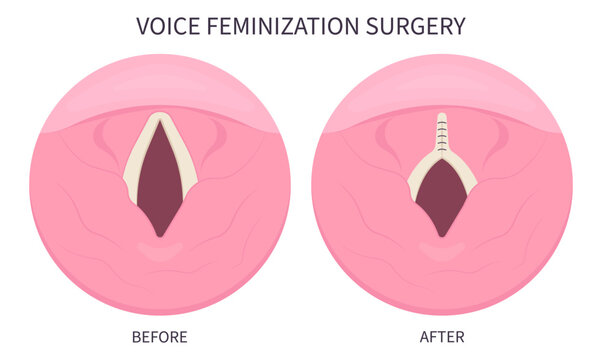Voice Feminization Surgeries: Surgical Options for a Softer, More Feminine Voice
Our voice is an essential part of our identity and directly influences how we express ourselves. A naturally deep voice or one that does not become softer due to hormonal factors can cause a mismatch between a person’s identity and their voice tone. Especially for trans individuals, those seeking a more feminine voice, or people with naturally deep voices, voice feminization surgery offers the opportunity to achieve a higher-pitched, softer, and more feminine voice.
Today, surgical procedures aimed at voice feminization are becoming increasingly successful, giving individuals the chance to achieve the voice they desire.
What Is Voice Feminization Surgery?

Voice feminization surgery is a procedure that modifies the anatomical structure of the vocal cords to achieve a higher-pitched, thinner, and sharper voice. These surgeries increase vocal pitch by either tightening or shortening the vocal cords.
The most common surgical techniques for voice feminization include:
- Glottoplasty (Vocal Cord Shortening Surgery – Wendler Glottoplasty)
- Cricothyroid Approximation (CTA)
- Anterior Web Glottoplasty
- Laser Vocal Fold Reshaping (Feminizing Laryngoplasty)
Each method is selected based on the patient’s vocal characteristics, expectations, and individual needs.
Who Is a Candidate for Voice Feminization Surgery?
- Trans individuals (especially MTF – male-to-female transitions)
- Individuals with naturally deep voices who wish to feminize their voice
- Those whose voice has not softened despite hormone therapy
- Individuals experiencing a mismatch between voice tone and gender identity
Before considering surgery, individuals are encouraged to try voice therapy to feminize their voice naturally. If these efforts are insufficient, surgical options may be explored.
Glottoplasty (Wendler Glottoplasty)
Glottoplasty involves shortening the front portion of the vocal cords by bringing them closer together.
How Is It Done?
- The vocal cords are visualized through the mouth using laryngoscopy.
- The front part of the vocal cords is fused using laser or sutures.
- Shortening the vocal cords increases pitch, resulting in a thinner voice.
Advantages
- Provides a significant increase in vocal pitch.
- Creates a permanent change.
- Can be performed endoscopically instead of open surgery.
Disadvantages
- May not be sufficient for individuals who want to reach very high notes.
- The recovery period may take 6–8 weeks.
Cricothyroid Approximation (CTA)
This technique increases vocal pitch by tightening the vocal cords.
How Is It Done?
- A small incision is made in the front of the neck to bring the cricoid and thyroid cartilages closer together.
- This procedure stretches the vocal cords, creating a higher-pitched voice.
Advantages
- Offers a quicker recovery process.
- Creates a thinner voice while preserving the natural sound.
Disadvantages
- May cause the voice to become too high-pitched.
- May not be permanent in some patients and could regress over time.
Anterior Web Glottoplasty
How Is It Done?
- A small incision is made at the front of the vocal cords to reduce their length.
- Shorter vocal cords result in a higher-pitched voice.
Advantages
- Provides permanent results.
- Helps achieve a natural-sounding feminine voice.
Disadvantages
Speaking may be difficult during the first few weeks.
Laser Vocal Fold Reshaping (Feminizing Laryngoplasty)
How Is It Done?
- Laser is used to shorten and thin the vocal cords.
- Increased tension of the vocal cords results in a higher-pitched voice.
Advantages:
- Can be performed without traditional surgery using a laser technique.
- Does not require stitches and has a shorter recovery time.
Disadvantages:
Suitable for mild voice changes; may not be sufficient for advanced feminization.
Post-Surgical Recovery After Voice Feminization
- Speech restriction: Refrain from speaking or whispering for the first 2–4 weeks.
- Voice therapy: Post-operative therapy is recommended to learn proper voice use.
- Recovery time: Voice changes may continue for the first 3 months; final results appear within 6 months.
- Avoid acidic and spicy foods: Recommended to prevent throat irritation.
Advantages of Voice Feminization Surgery
- Provides natural and permanent voice changes.
- Yields the best results when combined with voice therapy.
- Improves psychological and social well-being.
- Supports the gender affirmation process for trans individuals.
Voice Therapy or Surgery?
- If natural voice feminization is desired, voice therapy should be tried first.
- If voice therapy is not sufficient, surgical options can be considered.
- Voice feminization surgery is suitable for those seeking a permanent and definitive solution.
Conclusion
Voice feminization surgeries are effective options for individuals who wish to achieve a softer and higher-pitched voice. With techniques such as glottoplasty, cricothyroid approximation, and laser reshaping, it is possible to make the voice sound more feminine or lighter.
If you are not satisfied with your voice and natural methods are not sufficient, consult an ENT or phoniatrics specialist for detailed information about voice feminization surgery.
Your voice is a part of your identity – achieving the voice you desire is possible!


